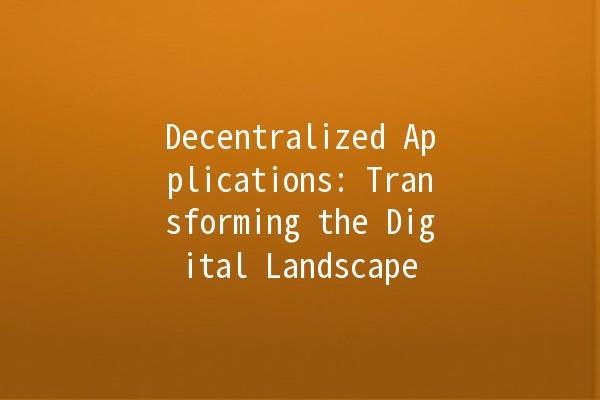
In the everevolving world of technology, decentralized applications (dApps) are rapidly gaining traction, revolutionizing how users interact with the digital landscape. Unlike traditional applications that rely on centralized servers, dApps operate on blockchain technology, ensuring enhanced security, transparency, and user autonomy. This article aims to delve into the realm of decentralized applications, providing valuable insights, practical tips, and strategies for enhancing productivity while navigating this innovative space.
Understanding Decentralized Applications
Decentralized applications are defined by their reliance on blockchain or peertopeer networks, rather than the conventional clientserver architecture. This fundamental shift in design offers several distinct advantages:
Popular Use Cases of Decentralized Applications
The growing ecosystem of dApps spans various sectors, each harnessing blockchain technology in unique ways. Here are a few notable examples:

Boosting Productivity with Decentralized Applications
While the concept of decentralized applications is captivating, navigating this new terrain can be challenging. Here are five practical tips to enhance productivity when engaging with dApps:
Understanding the underlying technology of dApps is crucial for maximizing their potential. Familiarize yourself with core blockchain concepts like consensus mechanisms, smart contracts, and tokenomics. Resources such as online courses, webinars, and community forums can provide valuable insights.
Example: Take a course on platforms like Coursera or Udemy that focuses on blockchain fundamentals, allowing you to grasp key concepts that can enhance your decisionmaking when selecting dApps.
Many dApps are built with complex interfaces that can be daunting for new users. Seek out dApps that prioritize user experience and simplify interactions. Opt for platforms that offer stepbystep guides and tutorials to ease the onboarding process.
Example: Platforms like MetaMask integrate seamlessly with various dApps, providing intuitive interfaces that simplify navigation and transaction processes.
The dApp ecosystem thrives on community engagement. Participating in online forums, Discord servers, and social media groups can help you connect with experienced users who can offer guidance and support.
Example: Join the Ethereum community on Discord to discuss your experiences and seek advice on specific dApps, benefiting from collective knowledge.
Engaging with dApps can involve financial investments, making risk management essential. Establish a strategy that outlines how much you are willing to invest, your risk tolerance level, and the potential impacts of market volatility.
Example: Allocate a percentage of your portfolio to dApps, ensuring it remains a small portion of your overall investments to mitigate risk exposure.
To enhance your productivity with dApps, maintain a record of your interactions and transactions. Utilize tools and analytics platforms to track your performance and make datadriven decisions.
Example: Use portfolio management tools like Zapper or Zerion to analyze your dApp transactions and track your overall performance, aiding you in optimizing your strategies.
Frequently Asked Questions About Decentralized Applications
Decentralized applications operate on a blockchain or peertopeer network, while traditional applications rely on a centralized server. This distinction gives dApps advantages in terms of user control, security, and transparency.
dApps benefit from blockchain's inherent security features. Transactions are recorded on a public ledger, reducing the risk of fraud and unauthorized access. However, users must remain cautious of phishing attacks and ensure they're using trusted dApps.
While some familiarity with blockchain may be beneficial, many dApps are designed with userfriendly interfaces that make them accessible to a broader audience. Educational resources can enhance your understanding and usability.
Yes! Developers can utilize various blockchain platforms, such as Ethereum, to create their own dApps. However, a deep understanding of smart contracts, programming languages, and blockchain principles is essential for successful development.
Gas fees are transaction costs paid on the Ethereum network and other blockchains to incentivize miners. Understanding these fees is crucial for effectively managing costs when using dApps.
Many experts believe that dApps represent a shift towards a more usercontrolled internet that emphasizes privacy, security, and transparency. Their continued development could lead to transformative changes across various industries.
Decentralized applications are at the forefront of a digital revolution that emphasizes user empowerment, security, and transparency. As we navigate this emerging landscape, embracing the practical tips and strategies outlined can significantly boost productivity and enhance your experience with dApps. By educating ourselves, leveraging community knowledge, and staying informed, we can harness the full potential of decentralized applications and contribute to shaping a more equitable digital future.

